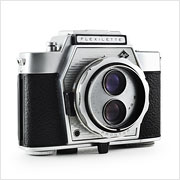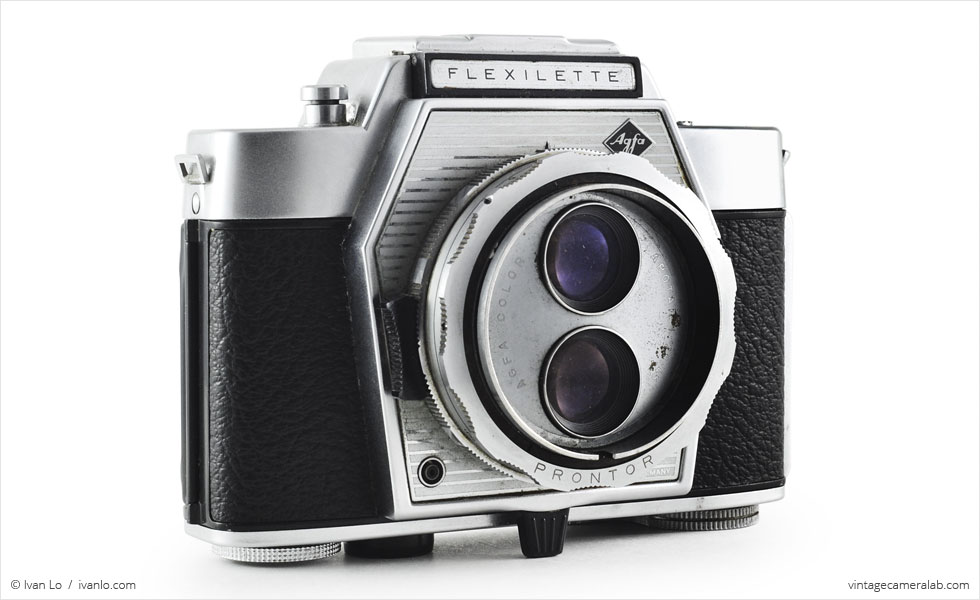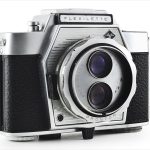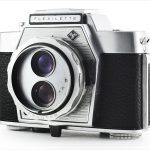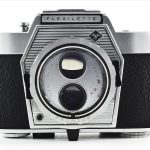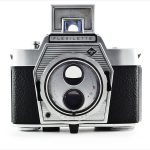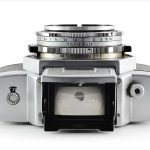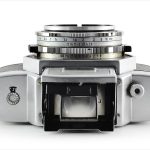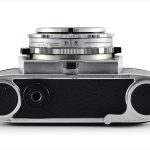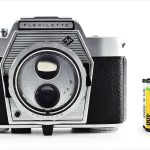Agfa Flexilette Specifications
| Manufacturer: | Agfa AG |
| Origin: | West Germany |
| (modern day Germany) | |
| Made in: | West Germany |
| (modern day Germany) | |
| Introduced: | 1960 |
| Type: | Twin Lens Reflex |
| Format: | 135 Film |
| Dimensions: | 13.5 x 10 x 6.6 cm |
| 13.5 x 12.6 x 6.6 cm (viewfinder open) |
Agfa Flexilette Overview
The Agfa Flexilette is an uncommon 35mm twin lens reflex camera introduced by Agfa in 1960 and only produced for about a year. Since the vast majority of twin lens reflex cameras are medium format like the Rolleicord, the Flexilette—along with its successor: the Optima Reflex—joins other oddballs like the Bolsey Model C as one of the only 35mm twin lens reflex cameras ever made.
Perhaps the most striking part of the Flexilette are its two 45mm f/2.8 Apotar lenses stacked on top of one another. The first ring surrounding the lenses can be rotated to tune focus, the next ring towards the body controls the aperture, and the last ring (rotatable via a pair of black tabs) sets the Prontor shutter’s speeds (1-1/500 seconds and Bulb). Besides the lens, the only feature of note on the front of the camera is a flash sync socket located near the seven o’clock mark on the circular lens board.
The Flexilette’s top plate is dominated by its viewfinder which can be unlocked by shifting the small metal button (which is missing on mine) on the back to the left. Once deployed, the viewfinder can either be used as a waist-level finder (with a deployable magnifier for fine-tuning) or at eye level by peering through the round eyepiece. A threaded shutter button is located on the user’s right-hand side with a film type indicator and frame counter (advanced by shifting the small metal button located just underneath it on the back) on the left. A larger metal button on the back marked as “R” releases the film for rewinding after the roll is used up. The frame advance lever is located on the bottom opposite the tripod socket and film rewind knob. The film door release latch can be found just underneath the user’s left-hand side strap lug.
I got this Flexilette through eBay for a very reasonable price which unfortunately means that the condition of my example is just okay. Apart from some scratches and blemishes, the only issue is that the viewfinder (which is missing the leatherette, an extremely common issue with these cameras) no longer latches because of the missing release button. Still, it’s a camera that’s as gorgeous as it is unusual.
Find your very own Agfa Flexilette on eBay.
McKeown, James M. and Joan C. McKeown’s Price Guide to Antique and Classic Cameras, 2001-2002. (Grantsburg, WI, USA: Centennial Photo Service, 2001), p 20.
